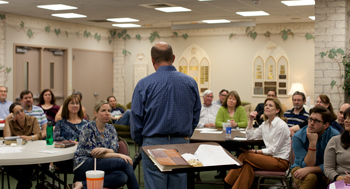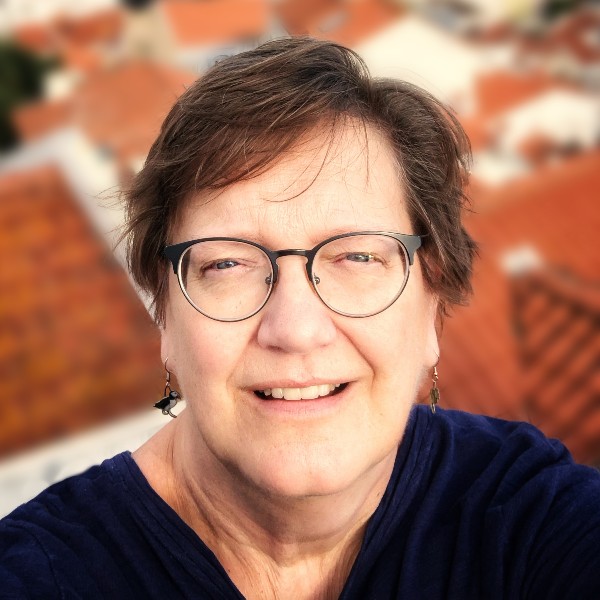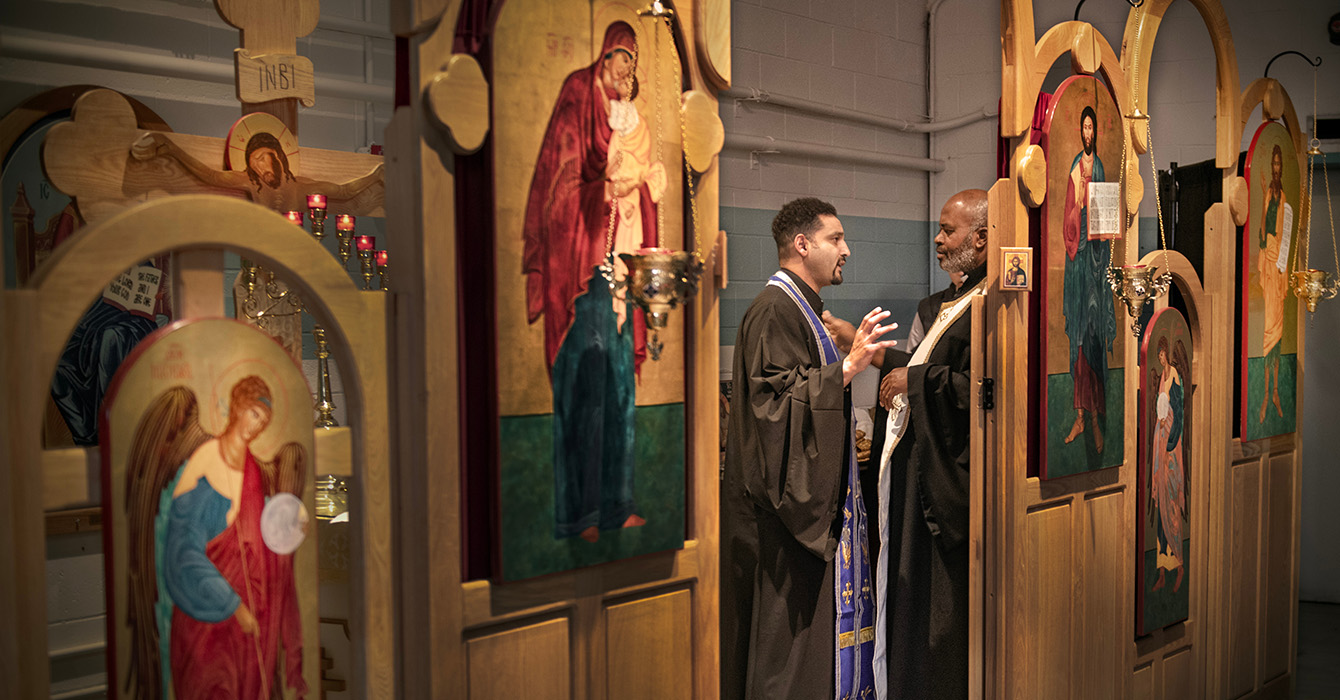Update: Riverside Community Church moved into a former steakhouse building in Bulverde, Texas, in 2014.
Situated close to Highway 281’s frenetic northbound lanes, about 30 miles north of downtown San Antonio, Texas, a coffeehouse called The Loft beckons visitors into its cozy interior.
Visitors are enveloped by the warmth of a wood fire and the smell of fresh-ground coffee and cinnamon rolls. Cushy leather sofas frame the stone hearth, and a wooden staircase leads to a loft with work stations.
“Customers might not know that this is a church,” said Tami Piatnik, who works on Saturdays. Indeed, The Loft displays few crosses or other signs of its affiliation with the United Methodist Church.
Though it wears its identity lightly, The Loft coffeehouse is a core ministry of Riverside, a church community in Spring Branch, Texas, (pop. 7,200) planted six years ago by San Antonio’s Alamo Heights United Methodist Church.
Riverside was born of a pastor’s two epiphanies: One by the Jordan River in Israel, and one in a Texas Starbucks.
The church plant began with The Loft coffeehouse, then expanded to include a food bank, thrift store and a resource center for the needy -- all before it held its first Sunday service.
Though Riverside now holds two Sunday services with about 500 worshippers, the community still has no formal membership and owns no church buildings.
“We’re the smallest church you’ll ever meet, because we have zero members,” said the Rev. Scott Heare, Riverside’s pastor. “Or, we’re the largest church you’ll ever see because we believe that all people in our community belong.”
A church in transition
The Rev. David McNitzky is the popular and erudite pastor of Alamo Heights, a 5,000-plus member “high-Methodist” congregation. It is the second-largest United Methodist Church in the Southwest Texas Conference, founded in 1909.
McNitzky joined the Alamo Heights staff in 1995, soon after the church moved to its 13-acre hilltop campus dominated by a soaring sanctuary. Locals have dubbed it “the Methodome,” a not-especially-welcome reference to San Antonio’s Alamodome.
Though clearly a successful leader of a venerable church community, McNitzky found that Alamo Heights was not immune to the national trend of declining attendance.
“Those who used to come every Sunday came for three weeks, those who used to come three Sundays came two, and so on,” McNitzky said. “If people could drop away from worship so quickly, what were we really doing? Were we really helping them? Were we really growing them?”
The trend caused McNitzky to reevaluate, and now he is piloting what he describes as a traditional church undergoing a transition. Alamo Heights has been renewed and challenged by its leaders’ conviction that the future of Christianity lies in actions that advance God’s kingdom.
And his willingness to empower other pastors and lay leaders to experiment has helped bring about that transition.
“It takes some courage to try and do something in a brand new way,” said Robert Scott, a longtime member and former trustee of Alamo Heights. “David is very permission-giving.”
Being Missional
The Rev. Heare is a young and energetic minister, a graduate of Southern Methodist University’s Perkins School of Theology. After arriving at Alamo Heights, Heare found in McNitzky a “spiritual father,” mentor and close friend.
Alternately, McNitzky said that his younger partner has challenged and surprised him over the years. When together, their easy-going enjoyment of each others’ company is tangible.
Both pastors share a keen interest in the Jewish roots of Christianity, in particular the teachings of the Rev. Ray Vander Laan, who advocates that Christians draw lessons from the Hebrew culture of Jesus’ day.
They also share a commitment to the missional church, which McNitzky defines as “simply meaning you’re there for others, to be in the world, not trying to gather people into the building.”
Soon after arriving, Heare pioneered a contemporary worship service that draws younger families, and McNitzky realized his associate had a gift for innovation. “When Scott first came, he was obviously talented and gifted. I got a sense from God, in a way, that I was David and he was Solomon, and the next big building is his, not mine.”
Neither pastor knew that “the next big building” would not be a building at all.
A lesson at the Jordan River
In 2002, McNitzky initiated a strategic planning process for the church. The planning group’s method was to read and discuss books on church growth. “After several months, we weren’t getting anything,” he said.
Turning to prayer, McNitzky changed the process to “strategic listening” in order to discern where God was leading the church.
The approach yielded a clear message -- three committee members, almost on the same weekend, got the same sense from God that they were supposed to start a second campus, McNitzky said.
That direction became even clearer after Heare had a pair of epiphanies.
The first came in the summer of 2003, when Heare visited the Jordan River on a study tour of Israel.
“The river was rushing and loud,” Heare said. “And the lesson was about while we present our lives as the calm water, the reality was our lives looked more like the white water. It’s God’s job to go into that chaos and to pull us out. The job of community is to be on the riverside with wet feet remembering that we’ve come from that -- and pulling others out.”
Heare was deeply moved by twin images of calm and chaos depicted in the story of Jesus’ baptism.
“I’m sitting in the Jordan River,” Heare said, “wondering what such a community would look like. It dawns on me, I’m supposed to be the one who goes and plants the church, and it’s supposed to be called Riverside.”
‘Create community’
Alamo Heights now had clear direction to create a new worshipping community and the choice of a pastor, but where would the church be planted and what would it look like?
This time the answer was to be found in a more mundane location: a San Antonio Starbucks.
A few months after returning from Israel, Heare was sitting in a coffeeshop, mulling over the step-by-step training he’d received in starting a new church, while taking in the scene around him. That day, the customers at the Starbucks included a group of sales reps and a women’s Bible study. On the window was a sticker that said, “Create Community.”
“Suddenly, it was brightly clear to me, and I burst out laughing,” Heare said. It occurred to him that he was sitting in the place he’d been seeking -- a meeting ground for the churched and unchurched. “I was sitting in the shephelah.”
Drawing from what he’d learned in Israel, Heare likened the Starbucks to an ancient region in Judea referred to as a shephelah, a term he used metaphorically to mean a meeting place among people of different faiths.
Grabbing his milk-and-sugar-laden coffee, Heare got in his car and started driving north.
All fall, Heare had been searching for a location to plant a new church, but nothing seemed right. On this day, fueled by caffeine and prayer, he drove past San Antonio’s suburban sprawl.
Pulling off the road, he saw a two-story ranch house with a “for rent” sign. The building owner happened to pull up, and soon Heare was touring the grounds, talking real estate. It had a barn and storage unit in the back, and a woman was painting the back porch -- getting the place ready for the next tenant.
“It was clear to me that this could work, and it freaked me out,” Heare said.
Then he faced the next step: Taking his idea to McNitzky and Alamo Heights’ leadership.
Questions to consider
Questions to consider:
- Are you “permission-giving” as a leader?
- Can you share new ideas with organizational stakeholders in a way that is respectful and effective?
- In what ways does your organization embrace both its commitment to identity and commitment to mission?
- How can you deepen your capacity to employ “strategic listening” to God and others?
- How do you develop relationships with people outside of the traditional structure of your organization?
Changing hearts
The birthing of Riverside was not without labor pains.
When the finance committee of the church heard that their long-studied new building was, first of all, a coffee shop and, secondly, located in Spring Branch, they initially balked.
“They formed a task force to do due diligence and came to the conclusion that we can’t afford a coffee shop, it will not make money, the rent’s too high,” Heare said. They said: “We’ll support your worshipping community. We will not support your coffee shop.”
The church wasn’t going to stop them, but they initially wanted the group to rent a cheaper place nearby.
They did have supporters, including Scott. “Our business model -- build it and they will come -- is no longer working. Riverside is an example of how you engage the culture rather than waiting for the culture to engage you,” Scott said.
Undaunted, the leaders of the nascent church began looking for ways to move ahead with limited resources. Church members learned about an auction of a foreclosed coffee shop, and with a small donation of $3,000, decided to attend. They bid and won equipment valued at $30,000.
“That weekend, all the people interested in Riverside filled their cars with [coffeehouse] equipment and drove it out to The Loft,” Heare said.
Heare also decided that to form a community, he needed to live in the community. He and his wife and children moved to Spring Branch, which was a disappointment to the contemporary worship community he had led at Alamo Heights.
Eventually the differences were resolved and the church began supporting Riverside. McNitzky is philosophical now about the hurt feelings the project created.
“I think a number of us felt like it was the thing to do, but we didn’t educate the congregation well enough about why we’re doing it,” he said. “The challenge is to be true to the message…and travel at the speed of life. We were so passionate, but we had to go at a level that the church could stay with us.”
Serving God -- and coffee
The Loft coffeehouse opened in early 2004, providing a place for the community to gather, for Bible study and for a core group of Riverside founders to meet. Most importantly, The Loft provided a place “for the unchurched and the churched” to meet in Spring Branch.
An extrovert, Heare set out to meet people in the community, getting to know the area better, and inviting them to Riverside. The Loft soon became a popular local hangout, becoming the shephelah he had envisioned.
Jenny Rudd, The Loft’s manager, tacked a note by the cash register that said, “You may be the only Bible someone ever reads.”
About six months after the coffeehouse opened, Pam Barquest, the woman Heare had encountered painting the porch on his first visit, started the Hope Center, a combination food pantry, thrift store and social service resource referral service. She had become a dedicated member of Alamo Heights and Riverside, and wanted to draw on her experience of being unemployed to help others.
The following spring, Riverside held its first Wednesday-night services in local homes, and later held them in the barn area behind The Loft.
“We were doing worship out there in 103 degrees,” Heare said. “We did not have a certificate of occupancy, no working bathrooms. We had something like 50 people…They were leaders. They were hungry. They were interesting. They were heavy prayer people.”
It would be more than a year after the founding of Riverside’s coffeehouse and Hope Center before they would start Sunday services, which now draw 500 people.
“What we’ve found is what works best is a more organic way of life, where things are birthed spontaneously within the community,” said Linda Marceau, a prayer leader at Riverside. “We’re a very close-knit community, very familial.”
Experimentation and stability
A few years ago, Heare participated in a worship service with McNitzky at Alamo Heights in which he apologized to the community for any immaturity in leadership or hurt feelings he had caused. The congregation was moved by this humble stance.
Today, Riverside and Alamo Heights are increasingly sharing resources and ideas, each bringing gifts to the larger congregation.
Pam Barquest of Riverside has started a Hope Center at Alamo Heights. The two communities are starting a speaker exchange, and the two ministers have founded something called “The Kingdom Leadership School” for training lay people.
“They’re almost like a laboratory,” McNitzky said of Riverside. “They teach us a lot, and we offer stability and encouragement and some resources.”
Those resources have increasingly come from Riverside itself. It has gradually become more financially independent. At first fully supported by Alamo Heights, it has become self-sustaining. Heare’s salary was shifted over a five-year period, and this year Riverside has 100 percent responsibility for the senior pastor’s salary.
Although Riverside technically has no membership structure , it collects offerings and pays expenses through offerings, donations and earnings from the Thrift Store and The Loft. Each quarter, Riverside reports to Alamo Heights’ general Finance Committee, and last year began contributing to the Methodist apportionment. Riverside is officially a campus of Alamo Heights, and Heare is on the staff of the mother church. If the members officially belonged to a church, it would be Alamo Heights, but people who inquire about membership are instead directed to participation in the community in other ways, such as Riverside's extensive home group network. McNitzky said they are still working out some details of this unconventional church.
In October 2009, 119 individuals and about 50 families received food through the Hope Center. Riverside also supports an orphanage in Uganda and a mission in Mexico, and plans are in the works to open a health clinic in Spring Branch.
The whole setup, said McNitzky, “speaks to our point that accountability is through relationship more than rules and policies.”
Today, Riverside thrives by walking out the biblical narrative in its own unconventional way. As its leader, Heare sees a lesson for the church more broadly.
“There’s a longing here for transition for the church as a whole. From traditional, to contemporary Bible churches, to all these structures that are an organic way of doing church...
“What David has shown me,” Heare said, “is how to lead during a dramatic transition in the church’s history. How do you lead from the ideas of the traditional church that are so comfortable into an entirely new way of being churched?”














